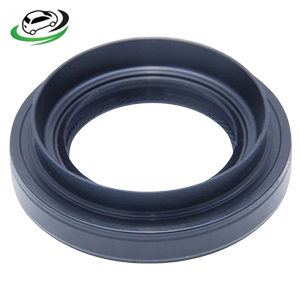Get Drive Shaft Oil Seal 40X64X9X15.6 Toyota Rav4 ACA3# 95HBY-40640916R
The drive shaft oil seal, often referred to as the differential seal, axle seal, or pinion seal, is a critical component in a vehicle’s drivetrain. It is designed to keep lubricants contained within the differential or transmission and prevent contaminants from entering these systems. Understanding the function, types, common issues, and replacement process of drive shaft oil seals is essential for maintaining vehicle performance and longevity. Here’s an in-depth look at these vital seals:
Function of the Drive Shaft Oil Seal
The primary function of the drive shaft oil seal is to maintain a barrier between the interior of the differential or transmission and the outside environment. Key functions include:
- Preventing Leaks: The oil seal prevents the lubricant within the differential or transmission from leaking out. Proper lubrication is critical for the smooth operation and longevity of gears and bearings.
- Excluding Contaminants: The seal also keeps dirt, water, and other contaminants from entering the differential or transmission. Contaminants can cause significant damage to internal components, leading to premature wear and failure.
- Maintaining Pressure: In some systems, the seal helps maintain the necessary internal pressure, ensuring the proper functioning of the lubrication system.
Types of Drive Shaft Oil Seals
Drive shaft oil seals come in various designs, each suited for different applications and conditions:
- Lip Seals: These are the most common type and feature a flexible lip that makes contact with the rotating shaft, creating a barrier to keep lubricant in and contaminants out.
- O-Ring Seals: These are simple rubber rings that provide a seal between stationary components. They are less common for drive shafts but may be used in certain designs.
- V-Ring Seals: These seals are used in applications requiring high levels of contamination protection. They have a V-shaped cross-section and can provide a secondary seal in combination with other seal types.
- Metal-Rubber Seals: These seals have a metal casing with a bonded rubber sealing surface, offering durability and resistance to high pressure and temperatures.
Common Issues with Drive Shaft Oil Seals
Over time, drive shaft oil seals can wear out or become damaged, leading to several potential issues:
- Oil Leaks: The most obvious sign of a failing drive shaft oil seal is oil leaking from the differential or transmission. This can lead to insufficient lubrication and increased wear on internal components.
- Contamination: If the seal fails to keep contaminants out, dirt and debris can enter the system, causing damage to gears and bearings.
- Noise and Vibration: A damaged seal may allow excess play in the drive shaft, leading to noise and vibration while driving.
- Premature Wear: A leaking seal can lead to low lubricant levels, causing gears and bearings to wear out faster than expected.
Symptoms of a Failing Drive Shaft Oil Seal
Recognizing the symptoms of a failing drive shaft oil seal can help prevent severe damage:
- Visible Oil Leaks: Oil spots under the vehicle near the differential or transmission are a clear sign of a leaking seal.
- Low Lubricant Levels: Regularly check the lubricant levels in the differential or transmission. A consistently low level may indicate a leak.
- Unusual Noises: Grinding or whining noises from the differential or transmission could indicate inadequate lubrication due to a leaking seal.
- Vibration: Excessive vibration, especially during acceleration or deceleration, can be a sign of a failing seal affecting the drive shaft’s alignment.
Replacement Process for Drive Shaft Oil Seals
Replacing a drive shaft oil seal involves several steps and requires some mechanical skill and tools. Here is a general outline of the replacement process:
Tools and Materials Needed
- New drive shaft oil seal
- Socket set and wrenches
- Screwdriver or seal puller
- Hammer and seal driver (or a suitable substitute)
- Lubricant
- Drain pan
- Jack and jack stands
- Safety glasses and gloves
Replacement Steps
- Safety First: Park the vehicle on a flat surface, engage the parking brake, and use jack stands to secure the vehicle. Ensure you have all necessary safety gear, such as gloves and safety glasses.
- Drain the Lubricant: Place a drain pan under the differential or transmission and remove the drain plug to allow the lubricant to drain completely.
- Remove the Drive Shaft: Depending on the vehicle, you may need to remove the drive shaft to access the oil seal. This typically involves unbolting the U-joints at the differential and sliding the drive shaft out.
- Remove the Old Seal: Use a screwdriver or seal puller to carefully pry out the old oil seal. Be cautious not to damage the surrounding surfaces.
- Install the New Seal: Apply a small amount of lubricant to the new seal to ease installation. Use a seal driver or a suitable tool to press the new seal into place evenly. Ensure it is seated correctly without distortion.
- Reinstall the Drive Shaft: Slide the drive shaft back into position and reattach the U-joints, ensuring all bolts are securely tightened.
- Refill the Lubricant: Replace the drain plug and refill the differential or transmission with the appropriate lubricant to the correct level.
- Check for Leaks: After the replacement, start the vehicle and check for any leaks around the new seal. Ensure everything is functioning correctly.
Maintenance Tips
To extend the life of your drive shaft oil seal and prevent premature failure:
- Regular Inspections: Periodically inspect the drive shaft oil seal for signs of wear or damage, especially after driving in harsh conditions.
- Maintain Lubricant Levels: Keep the differential and transmission properly lubricated. Low lubricant levels can increase wear on the oil seal and other components.
- Address Issues Promptly: If you notice any symptoms of a failing oil seal, address them promptly to prevent further damage and costly repairs.
Follow us on Facebook for more parts.



